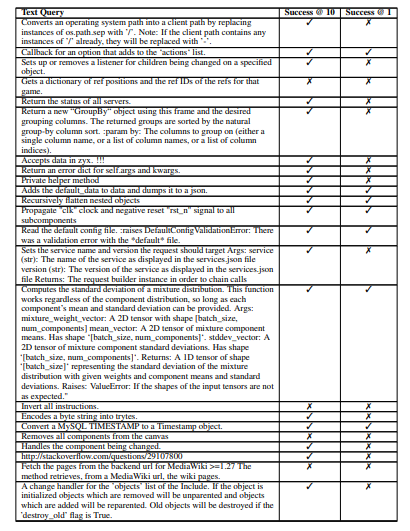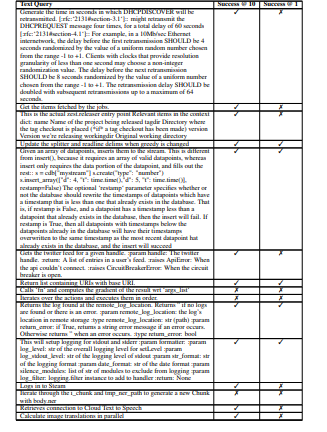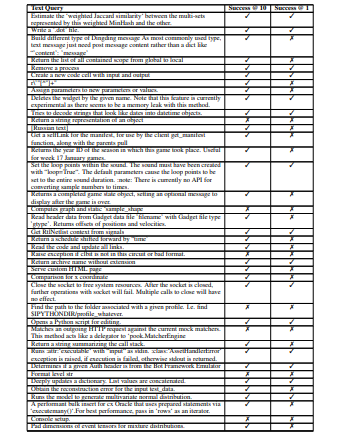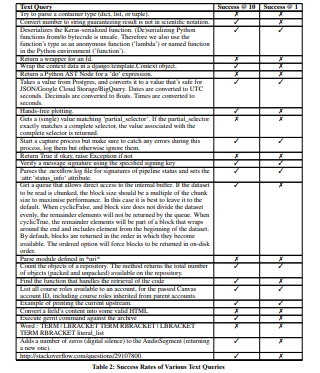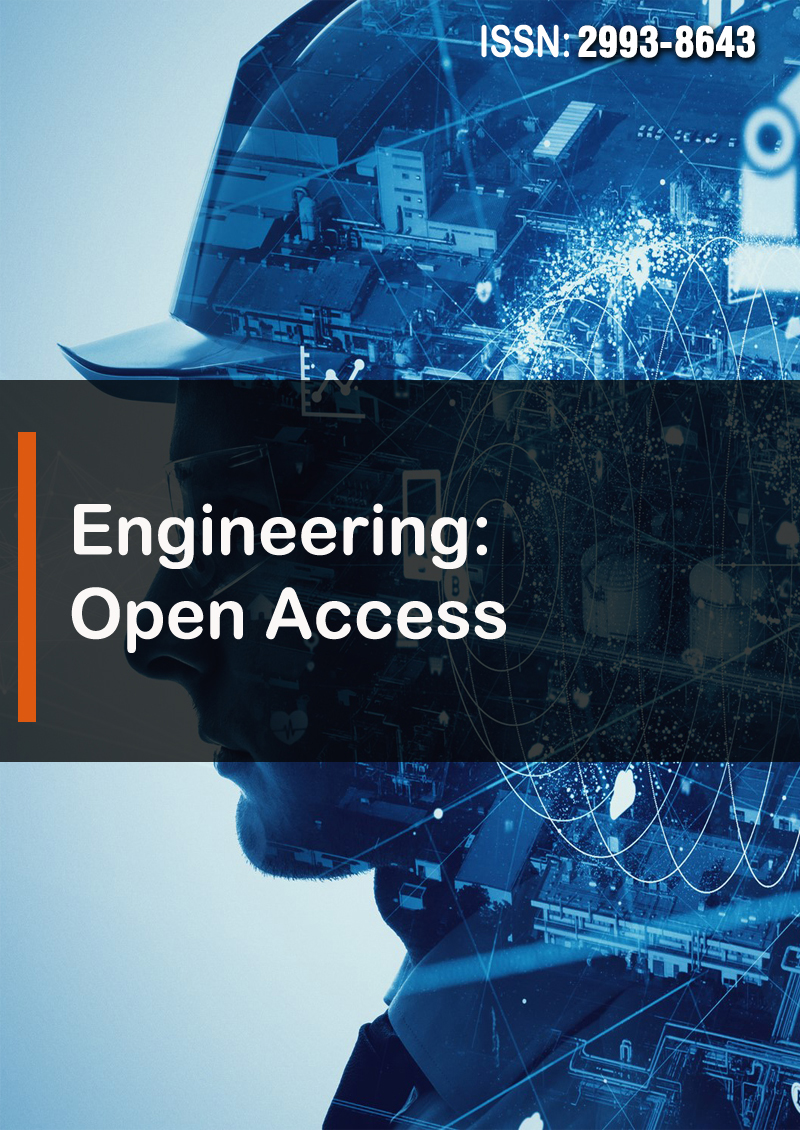Research Article - (2024) Volume 2, Issue 5
Llm Agents Improve Semantic Code Search
Received Date: Sep 26, 2024 / Accepted Date: Oct 31, 2024 / Published Date: Dec 20, 2024
Copyright: ©2024 Sarthak Jain, et al. This is an open-access article distributed under the terms of the Creative Commons Attribution License, which permits unrestricted use, distribution, and reproduction in any medium, provided the original author and source are credited.
Citation: Jain, S., Sam, K. S., Dora, A., Singh, P. (2024). Llm Agents Improve Semantic Code Search. Eng OA, 2(5), 01-10.
Abstract
Code Search is a key task that many programmers often have to perform while developing solutions to problems. Current methodologies suffer from an inability to perform accurately on prompts that contain some ambiguity or ones that require additional context relative to a code-base. We introduce the approach of using Retrieval Augmented Generation (RAG) powered agents to inject information into user prompts allowing for better inputs into embedding models. By utilizing RAG, agents enhance user queries with relevant details from GitHub repositories, making them more informative and contextually aligned. Additionally, we introduce a multi-stream ensemble approach which when paired with agentic workflow can obtain improved retrieval accuracy, which we deploy on application called repo-rift.com. Experimental results on the CodeSearchNet dataset demonstrate that RepoRift significantly outperforms existing methods, achieving an 78.2% success rate at Success@10 and a 34.6% success rate at Success@1. This research presents a substantial advancement in semantic code search, highlighting the potential of agentic LLMs and RAG to enhance code retrieval systems.
Introduction
A key task that many programmers often perform is searching through codebases to find snippets that can solve specific problems. This practice coined as code search is essential for facilitating code reuse [1]. While traditional code search involves the usage of keyword matching, code search has evolved to learn and predict on the semantics behind queries and snippets allowing programmers to more accurately retrieve code that aligns with their intent. Recent advances in deep learning have been at the center of current methodologies. Through training large language models (LLM) on large corpora of text and code, LLMs have obtained strong natural language to code generation capabilities which has extended to better semantic code search. Notable research in this domain includes "Deep Code Search", which utilizes recurrent neural networks, to learn sequential information behind code and their descriptions and consequently map them into a unified vector space [2]. Building upon DeepCS, other architectures like Carl-CS which exploits co-attentive representation learning and PSCS which focuses on using code flow obtained from Abstract Syntax Trees also improved code search capabilities [3,4]. Other significant work in this domain is "CodeBERT: A Pre- Trained Model for Programming and Natural Languages", which leverages a bi-modal transformer to jointly model programming and natural languages, significantly enhancing the model’s ability to form accurate embeddings based on semantic content. Building on this approach, the paper "Text and Code Embeddings by Contrastive Pre-Training" by OpenAI introduces a contrastive learning technique paired with unprecedented large training data to generate state of the art embeddings for both text and code, further enhancing the ability (even above CodeBERT and variations like GraphCodeBERT to match natural language queries with relevant code snippets by distinguishing subtle differences in meaning across various contexts [5-7].
Despite these advancements, semantic code search still faces many challenges. Natural language queries provided by a user can be ambiguous or requiring more detail. One example of this is the Vocabulary Mismatch Problem where different individuals use varying keywords or terms to describe the same concept or functionality, or the same keywords to describe different functionalities. For instance, the term "model" can refer to a machine learning model, a database schema, or a software design pattern [8]. Even in the field of Artificial Intelligence, for example, the keyword "Positional Encoding" has a different context and purpose when referring to attention mechanisms in transformers compared to its use in neural radiance fields [9,10]. This issue can lead to weak code search results or force a user to do extra work to provide additional details in their input prompt.
In this paper, we propose using agentic large language models (LLMs) to improve semantic code search. Agentic LLMs involve multiple specialized agents working collaboratively to handle different aspects of a task. Using agents lead to more powerful capabilities than single LLMS due to their augmented reasoning and ability to decision make [11]. In the context of semantic code search, these agents are designed to append useful information to the user prompt. By using Retrieval Augmented Generation (RAG), the system looks up information on the internet pertaining to a specific GitHub repository to understand its context. This allows agents to recursively call prompts, injecting relevant information into a user’s natural language query and effectively adding enough detail to eliminate the Vocabulary Mismatch Problem. Therefore, compared to previous research that focuses on improving mappings between natural language and code specifically, we focused on augmenting the user prompt via RAG powered agents. Through our results, we have shown how such augmentations trickle down and improve the performance of already created embedding based methods. We utilize OpenAI’s state-of-the-art text embeddings as they currently have the strongest performance in prominent code search evaluation sets like CodeSearchNet. [6]. Additionally, we translate the natural language output of agents into code to improve code search. The purpose of this is to bridge the semantic gap between human-readable natural language queries and code snippets in order to improve search accuracy and relevance in code search engines [8]. To maximize the accuracy of our code search results, we implement an ensemble approach. This approach involves conducting multiple comparisons to identify the most relevant code snippets.
Additionally, we have built an online website, RepoRift, which implements these advanced code search techniques delineated in the paper. This platform allows for any user to enter in a github repository and ask their own natural language queries for code search. For more details, visit www.repo-rift.com. To summarize, our main contributions are:
Information Injection Via Agentic Large Language Models (LLMs) and Retrieval Augmented Generation (RAG)
We use agents with RAG internet search capabilities to augment user prompts to break down technical terms, contain more specific information, and alleviate the Vocabulary Mismatch Problem. Moreover, we have shown how such a strategy leads to better inputs for embedding models.
Ensemble Architecture with Multi-Stream Comparisons
We utilize OpenAI’s state-of-the-art text embeddings to capture nuanced meanings, translating natural language queries into code and using an ensemble approach with multi-stream comparisons. This method enhances the accuracy and relevance of retrieved code snippets by examining multiple facets of the query and code context.
RepoRift Platform
We developed www.repo-rift.com, an online platform that implements these advanced techniques, providing developers with a practical tool for code searches. Powered by the architecture discussed in this paper, RepoRift offers a novel solution in 3 ways
• It narrows down the context of a query to a single repository,
• It uses agentic interactions to hone accuracy and efficacy, and
• It returns easy-to-read results in a timely manner. Visit www. repo-rift.com for more details. Currently only Python is supported.
Methodology
Information Injection via Agentic Large Language Models (LLMs) and Retrieval Augmented Generation (RAG)
Given a natural language query Q and a GitHub repository database D, as seen in Figure 1 we enhance the query using an agent with internet access. The agent’s primary objectives are to contextualize Q relative to D and to enrich Q with additional details, thereby improving the match between the user input and the correct code snippet.
Our agent architecture, built using the CrewAI framework on top of OpenAI’s GPT-4 model, functions as a "Technical Research Writer." The agent augments the query based on the prompt:
"Given an input text prompt: [Q]. Add more technical details about some of the topics in this text prompt in the general context of the following github repo: [D]. If you can’t find how it is implemented in the repository, then provide information on how it is implemented generally. Ensure that you are not given more info than necessary and only give info on specifically the topics present in the input text prompt. Your paragraph will help localize the ideas in the input text prompt in a large repository so deviating from topic can lead to inaccuracies down the pipeline. You are on a timer be quick, so you must be called two times at most and look at one website at most each time called".
This approach ensures the augmentation is relevant and focused on the topics present in the query.
We employ a retrieval-augmented generation (RAG) technique, where information is first gathered from the internet. The retrieved information, determined to be relevant based on embedding cosine similarity, is then used to augment the query [12].
The output of the agent post-retrieval is the augmented prompt
A = Agent (Retrieval (Q, D)) (1)

Figure 1: An Example Showing the Idea of How A Natural Language Query Taken from Codesearchnet [13] is Augmented by Agents Allowing for Better Matching
Ensemble Architecture with Multi-Stream Comparisons
The purpose of the ensemble architecture is through many different comparisons, a more accurate final set of likely snippets can be formed. Additionally, during code generation, classes can be created with many different functions, and a multi-stream architecture that breaks down the generated code is needed. Once A is created, our methodology forwards it to multi-stream processes that work together to produce a small set of targeted snippets. In our implementation, all code (exclusively in Python) is divided into a set of functions Y and a set of classes Z. The initial step involves creating an embedding for A. Then the first stream compares the embedding of Q with the embeddings of each element in Y where the top 3 elements in Y with the largest cosine similarity to Q are added to the final target set
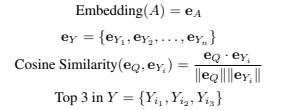
The second stream processes involves generation of code A through two chains of OpenAI’s GPT-3.5-turbo to generate code C and then evaluate its quality

C is then converted to an embedding and compared with the embeddings of each element in Y and Z
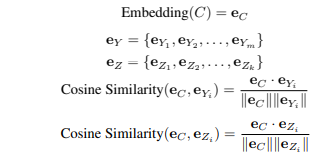
The top three snippets in both Y and Z with the highest cosine similarity to the vector representation of C are compiled and added to the final target set:

The final stream involves a comparison of component functions. C is broken down into its component functions. The embeddings of each component function are compared with the embeddings of each element in Y , and the smallest cosine similarity distance for each component function is added to the final target se
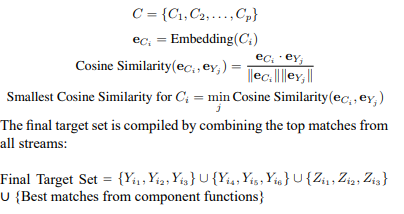
This multi-stream approach ensures a comprehensive and targeted selection of code snippets based on the initial input A. The creation of the final target set significantly reduces the number of potential code snippets from a large volume to approximately 5 to 15 snippets. To enhance the precision of similarity matching, we further process the final target set using GPT-4o to identify the most relevant snippets. It is important to note that GPT-4o has token limitations, making it impractical to input a large amount of snippet data directly. This constraint underscores the importance of using embeddings initially to generate a refined target set.
Experimental Setup
Dataset
Following, we leverage the CodeSearchNet dataset, which features numerous pairs of natural language queries and corresponding code snippets, all associated with specific GitHub repositories. To conduct our study, we manually processed each natural language query via repo-rift.com, randomly selecting 101 rows from the Python evaluation set of CodeSearchNet. To maintain fairness and ensure broad applicability, we included queries of varying lengths and only altered the natural language query if it detailed parameters or return types. Furthermore, some queries were left unmodified, even those containing parameter and return information, to uphold generalizability [4,13].
We excluded and replaced only those rows where the code snippet had been removed from the current main branch of the repository or when the repository size exceeded the upload capacity of our repo-rift.com application. The azure-sdk-python repo was the sole instance of the latter issue. We opted to exclude snippets not present in the main branch because our repo-rift.com application could not effectively upload files from previous branches, thus making replacement a more straightforward solution.
Implementation Details
For the backend of the RepoRift application, we employ thirdparty packages and OpenAI APIs. The agent is constructed using the CrewAI framework. The website is built with the Vue JavaScript framework and SQL, and it is deployed on a standard AWS plan. To evaluate our software, we manually input 101 rows of data into our website and observe the results displayed as panels on the right.
Evaluation Metrics
Following previous codesearch research from DeepCS [2], CARLCS [3] , and PSCS [4], we utilize the same Success@10 and Success@1 metrics to compare accuracy. While the aforementioned methods have been translated to evaluate the Java Dataset of CodeSearchNet, we test on the Python Dataset. Success@k is a metric that determines whether a detected code snippet from a system is in the top k results. Therefore, to be positively labeled in the Success@1 metric, the result must be the highest rank.

To determine the highest rank in our methodology, we look at all the streams in the multi-streamed process mentioned in the methods (Section 2.2), and take the snippet that was calculated with the highest cosine similarity. Additionally, since we reason that many methods can only be fully understood in the context of a class, we consider it a positive label if the class of the correct snippet is detected by RepoRift even if the individual function is not.
Results
We compare our methods to other baselines with the most similar evaluation setups. The evaluation for PSCS, CARLCS, and DeepCS have all been translated to CodeSearchNet, where they are given thousands of snippets and expected to find the correct snippet according to a provided natural language query. While these three methods have been built for Java, all we do differently is test on Python. And while the previous baselines, as per, conduct a search over all test snippets in CodeSearchNet, we conduct a search over all snippets in a GitHub repository as that is what our use case is specifically designed [4]. We directly take the success rates from [4] and compare them with the success rates calculated through our evaluation, making the judgment that the difference is trivial. Additionally we remove comments from all code snippets to ensure an obvious fair evaluation.
We chose methods that most closely mimic the real-world use of a tool across different GitHub repositories. This approach involves a constantly dynamic set and size of distractor codes that have tighter relationships to the correct snippet. The models chosen for comparison, such as DeepCS, CARLCS, and PSCS, are highly cited. While we couldn’t find a specific well-cited piece of research that used a dynamic set of distractor codes, we selected methods with large static distractor sets. The methods we compared do not inherently use a dynamic set of distractor codes. However, their distractor sets are substantial, with 19k snippets, providing a robust benchmark for evaluation. When ranking from 1 to 10, we make the sound conclusion that the distractor snippets from 10 to 999 would be significantly different each time a new natural language query is processed unlike the fixed distractor codes present in CodeBERT [5]. This variation closely simulates a dynamic distractor set, making our comparisons relevant and comprehensive.
Table 1 provides the evaluation results, comparing our method, RepoRift, against the baselines. The success rates are measured at two levels: Success@10 and Success@1, which indicate the percentage of correct snippets found within the top 10 and the top 1 results, respectively. Despite not being optimized for Success@1 due to its ensemble approach, RepoRift significantly outperforms all other methods. Specifically, RepoRift achieves an 78.2% ±8.1 success rate at Success@10, which has a lower bound accuracy that is approximately 22.5% better than the highest-performing baseline (PSCS at 47.6%). For Success@1, RepoRift achieves a 34.6% ±9.3 success rate, which has a lower bound accuracy that is approximately 2.4% better than the highest-performing baseline (PSCS at 22.9%).
RepoRift achieves high accuracy with minimal preprocessing of the evaluation set. It effectively handles queries in various forms, including those written in Russian, raw URLs, and vague conceptual information. This versatility showcases RepoRift’s capability to understand and process a wide range of input types without requiring extensive preprocessing. These results demonstrate that RepoRift not only outperforms other methods in both Success@10 and Success@1 metrics but also does so while maintaining a high level of flexibility and minimal preprocessing. The improvement in success rates highlights the effectiveness of our approach in searching and identifying relevant code snippets in a larger and more diverse dataset.
Conclusion
In this paper, we presented the use of information injection as a methodology to improve code search. The reasoning behind such a use case was to add vital details to alleviate the vagueness and ambiguity present in a user prompt for a code search application. By leveraging agentic LLM models and RAG, our system was able to perform internet searches relevant to a prompt and github.
User Prompt: "convert a field’s content into some valid HTML"repository, consequently addressing the Vocubulary Mismatch Problem and allowing for context-aware searches.
We provide three main contributions. Firstly, we demonstrate how agentic LLMs in combination with RAG allow for further contextualization of queries, a methodology we coin as information injection. Secondly, by pairing this process with a multi-stream ensemble approach we achieve state-of-the-art accuracy for semantic code search. By translating the query to code and then utilizing many comparison to generate a final set, a larger variation of snippets are able to be captured. Finally for our third contribution, we deployed our advanced techniques onto a website called RepoRift (www.repo-rift.com). RepoRift allows users to perform semantic code searches within specific GitHub repositories. The platform’s practical utility and performance in real-world scenarios underscore the effectiveness of our approach.
Our experimental results, conducted on the CodeSearchNet dataset, show that RepoRift significantly outperforms existing methods such as DeepCS, CARLCS, and PSCS. Specifically, RepoRift achieved an 78.2% success rate at Success@10 and a 34.6% success rate at Success@1, demonstrating superior performance in both metrics. These results highlight the potential of our method to enhance the accuracy and relevance of semantic code searches. In conclusion, our research presents a significant advancement in the field of semantic code search. By integrating agentic LLMs and RAG, we have addressed critical challenges and improved the overall effectiveness of code retrieval systems.
Future Work
Further analyzing the full evaluation breakdown in section 6, we were able to discern several weaknesses in our approach that lays down a better idea for future work. While utilizing code generation before embeddings is helpful for code search, it struggles to account for snippets that are almost primarily constructed from other functions and classes within a codebase [2]. Therefore, while sometimes through naming conventions in generated code embeddings can still retrieve the right snippet, the code search results for this case are significantly weaker. For instance, below are two example of snippets that RepoRift was unable to identify ASTs or any form of translating code to where these other functions and classes are replaced with their raw code serves as possible area of future work to better address this issue.
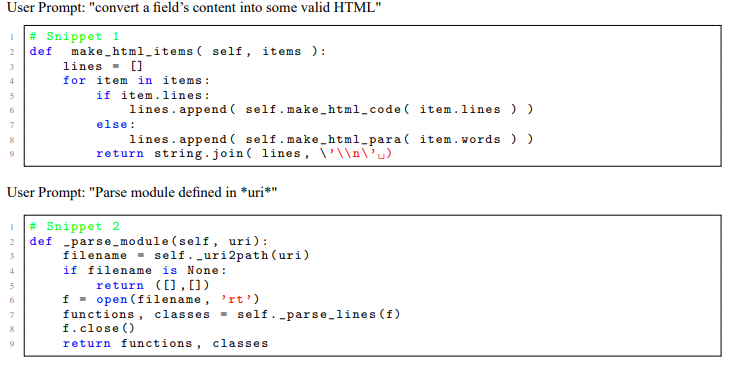
Acknowledgement
We acknowledge Prabhat Singh from Cisco for their valuable advice and support. This work was conducted indepen- dently and did not utilize any company resources or proprietary information.
References
1. Liu, C., Xia, X., Lo, D., Gao, C., Yang, X., & Grundy, J. (2021). Opportunities and challenges in code search tools. ACM Computing Surveys (CSUR), 54(9), 1-40.
2. Gu, X., Zhang, H., & Kim, S. (2018, May). Deep code search. In Proceedings of the 40th International Conference on Software Engineering (pp. 933-944).
3. Shuai, J., Xu, L., Liu, C., Yan, M., Xia, X., & Lei, Y. (2020, July). Improving code search with co-attentive representation learning. In Proceedings of the 28th International Conference on Program Comprehension (pp. 196-207).
4. Sun, Z., Liu, Y., Yang, C., & Qian, Y. (2020). PSCS: A path- based neural model for semantic code search. arXiv preprint arXiv:2008.03042.
5. Feng, Z., Guo, D., Tang, D., Duan, N., Feng, X., Gong, M., ... & Zhou, M. (2020). Codebert: A pre-trained model for programming and natural languages. arXiv preprint arXiv:2002.08155.
6. Neelakantan, A., Xu, T., Puri, R., Radford, A., Han, J. M., Tworek, J., ... & Weng, L. (2022). Text and code embeddings by contrastive pre-training. arXiv preprint arXiv:2201.10005.
7. Guo, D., Ren, S., Lu, S., Feng, Z., Tang, D., Liu, S., ... & Zhou, M. (2020). Graphcodebert: Pre-training code representations with data flow. arXiv preprint arXiv:2009.08366.
8. Gu, X., Zhang, H., & Kim, S. (2018, May). Deep code search. In Proceedings of the 40th International Conference on Software Engineering (pp. 933-944).
9. Ashish Vaswani, Noam Shazeer, Niki Parmar, Jakob Uszkoreit, Llion Jones, Aidan N. Gomez, Lukasz Kaiser, and Illia Polosukhin. Attention is all you need, 2023.
10. Mildenhall, B., Srinivasan, P. P., Tancik, M., Barron, J. T., Ramamoorthi, R., & Ng, R. (2021). Nerf: Representing scenes as neural radiance fields for view synthesis. Communications of the ACM, 65(1), 99-106.
11. Li, X. (2024). A Survey on LLM-Based Agentic Workflows and LLM-Profiled Components. arXiv e-prints, arXiv-2406.
12. Lewis, P., Perez, E., Piktus, A., Petroni, F., Karpukhin, V., Goyal, N., ... & Kiela, D. (2020). Retrieval-augmented generation for knowledge-intensive nlp tasks. Advances in Neural Information Processing Systems, 33, 9459-9474.
13. Husain, H., Wu, H. H., Gazit, T., Allamanis, M., & Brockschmidt, M. (2019). Codesearchnet challenge: Evaluating the state of semantic code search. arXiv preprint arXiv:1909.09436.
Appendix
Full Evaluation Breakdown
We tested on 101 rows of CodeSearchNet. Table 2 presents the detailed results for each data point examined. Any one of these rows can be re-tested by using repo-rift.com.
